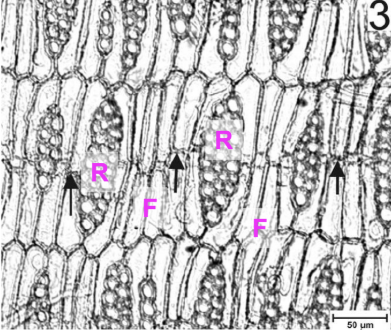Class 8
1/44
There's no tags or description
Looks like no tags are added yet.
Name | Mastery | Learn | Test | Matching | Spaced |
|---|
No study sessions yet.
45 Terms
Dermal Tissue:
Outer, protective tissues.
Ground Tissue:
Internal, fundamental tissues.
Vascular Tissue:
Conducting (transport) tissues.
When are the three tissue systems (dermal, ground, and vascular) established?
During primary growth.
In which plants does secondary growth occur?
Woody eudicots.
Secondary Growth:
Produce the same cell types as primary growth, but cells have a different origin and arrangment.
Vascular Cambium:
Secondary xylem (wood) and secondary phloem (inner bark).
What is the cork cambium?
Periderm (most of the bark).
Which lateral meristems are responsible for all secondary growth?
The vascular cambium and cork cambium.
What does the vascular cambium do?
Form secondary xylem to the inside and secondary phloem to the outside.
What is the cambium initial cell?
The stem cell, with each division, one daughter cell remains an initial, and the other will differentiate.
Anticlinal Division:
Perpendicular to the surface (adds cells to a layer).
Periclinal Divisions:
Create a new layer of cells (more layers of xylem or phloem).
Through which type of division does the vascular cambium produce secondary xylem and phloem?
Periclinal divisions.
What is the structure of the vascular cambium made up of?
Fusiform initials (F) and Ray initials (R).
Fusiform initials (F):
Long, have vertical orientation, and produce elongated cells of the phloem and xylem.
Ray Initials (R):
Short, have horizontal orientation, and produce parenchyma in “rays” that go across the xylem.

What type of section is this?
Tangential.

What type of section is this?
Transverse.
Why do ray initials divide?
To form ray cells that make up the vascular rays.
What are vascular rays?
Parenchyma cells that store starch, lipids, and proteins and produce/store some secondary metabolites.
What channels for movement do vascular rays do?
Water from 2 ̊ xylem to 2 ̊ phloem and food from 2 ̊ phloem to 2 ̊ xylem.
Where does the vascular cambium arise?
The procambium between the primary xylem and phloem and in the spaces between vascular bundles, forms a complete circle.
Is the vascular cambium found in monocots?
No.
Woody eudicot stem structure, early year 1:
Little secondary phloem and xylem and no cork cambium.
Woody stem structure, late year 1:
More secondary phloem and xylem and periderm developing.
What is the majority of secondary growth made up of?
Secondary xylem (wood).
Gymnosperm Wood:
“Softwood”, few fibers, little parenchyma, mostly tracheids, no vessels, ray parenchyma
Angiosperm Wood:
“Hardwood”, fibers, parenchyma, tracheids, vessel elements, ray parenchyma
What are the growth rings on wood a result of?
Differences in seasonal growth of secondary xylem.
Spring (early) Wood:
Wide-diameter vessels or tracheids.
Summer (late) Wood:
Smaller diameter vessels or tracheids.
Do growth rings show up in mild wet tropics?
No.
Does older wood function in transport?
No it does not.
Heartwood:
Center of stem, darker, harder, drier, no transport function, vessels get plugged up, ALL cells are dead, may accumulate secondary metabolites
Sapwood:
Outer (younger) parts of wood, lighter, softer, moister, water transport actively occurs, includes living cells (parenchyma).
What is the periderm?
The dermal tissue system of the secondary plant body that replaces the epidermis as the stem grows in diameter.
Which meristem produces the periderm?
The cork cambium.
What is the cork?
Protective tissue outside the cork cambium (contains suberin).
What is the phelloderm?
Parenchyma formed to the inside of the cambium (similar to cortex).
What do lenticels allow?
Gas exchange through the periderm.
What is bark?
Secondary phloem + periderm, ALL the tissues to the outside of the vascular cambium.
Vascular Cambium Facts:
Produces 2 ̊ phloem to the outside and 2 ̊ xylem to the inside each growing season, only the innermost layer of phloem conducts, older 2 ̊ phloem is crushed and ultimately sloughed off.
Cork Cambium Facts:
Produces cork to the outside and phelloderm to the inside, cork replaces epidermis during 2o growth, cork is regenerated for the life of the tree.
What happens as trunk diameter increases?
The epidermis, cortex, and older phloem are destroyed.